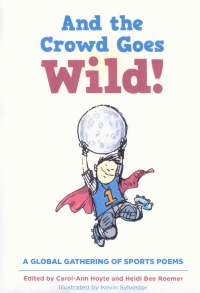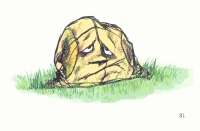| ________________
CM . . .
. Volume XIX Number 14. . . .December 7, 2012
excerpt:
In an interview posted on the Poetry for Children website on April 13, 2012 (www.poetryforchildren.blogspot.ca), Carol-Ann Hoyte, one of the co-editors of And the Crowd Goes Wild!, is quoted as saying, “The London 2012 Summer Olympics served as the inspiration for this anthology.” Hoyte, a Montreal-based poet and school librarian, further explained that “I sent the call for submissions to poetry groups/organizations based in several countries asking them to post it on their websites and to circulate it among their members.” Along with her co-editor, Heidi Bee Roemer, an American author and poet, Hoyte whittled the submissions down to the 50 sports-focussed poems that are found in And the Crowd Goes Wild!.
At first blush, athletics and poetry might seem as incompatible as oil and water, but the contents of And the Crowd Goes Wild! blend the two like love and marriage. The poems represent more than twenty poetic forms and are quite eclectic in the amateur and professional sports they cover as well as in their perspectives, tone and mood. Chess, soccer, table tennis, track and field events, diving, rappelling, kayaking, synchronized swimming and gymnastics are just some of the individual and team sports treated in the book. Inanimate objects, such as a stadium in “Stadium Speaks”, a soccer ball (see excerpt) and a piece of granite in “Curling Stone”, also get a voice, as does the fan in “i [sic] watch football with my father” and “Superfan”. Not all of the “athletes” are highly skilled as can be found in “Six Times a Charm” where the speaker unsuccessfully tries five sports before finding her/his game, checkers, or “The Letter” in which Hannah writes a letter to her coach (who also happens to be her father), asking to get off the bench and into the volleyball game. The poems don’t just deal with able-bodied athletes, and so “Goalball: Bonfire in Darkness” speaks to a game played by athletes with visual impairments while “Mono Skier” addresses a winter sport engaged in by paraplegic athletes. “The Master Dance: A Poem for Two Voices” compares and contrasts football and ballet. In “Pianoball”, someone has to practice playing the piano while listening to her/his friends playing baseball. Good sportsmanship is demonstrated in “Last Chance Bat”. “Thumbs Up” even suggests a new sport – Olympic texting! “The Sportsman or the Scientist?” poses an interesting question - which does our society value more? In a few cases, where a sport or athletic activity may not be well known, an explanatory note is added below the poem. An example is found at the conclusion of “Six Times a Charm” where “snooker” and “pot the blue” are explained. Brief biographical information about the collection’s poets can be found at www.crowdgoeswildpoems.com, with some of the entries containing photos of the poets as well as links to their websites. Though an introduction to And the Crowd Goes Wild! invites readers to visit the website “to learn how to write poems in these forms”, that part of the website does not appear to have yet been created. Teachers will especially appreciate “POETRY FORMS and POETIC DEVICES” (p. xi), a page which identifies which poems exemplify a particular poetic form, such as shape poem, or exhibit a poetic device, like hyperbole. And the Crowd Goes Wild! offers much to readers of all ages, whether they are athletes or not, and the poems can be valuable classroom resources for teachers from elementary through high school. Highly Recommended. Dave Jenkinson, CM’s editor, lives in Winnipeg, MB.
To comment
on this title or this review, send mail to cm@umanitoba.ca.
Copyright © the Manitoba Library Association. Reproduction for personal
use is permitted only if this copyright notice is maintained. Any
other reproduction is prohibited without permission.
NEXT REVIEW |
TABLE OF CONTENTS FOR THIS ISSUE
- December 7, 2012.
AUTHORS |
TITLES |
MEDIA REVIEWS |
PROFILES |
BACK ISSUES |
SEARCH |
CMARCHIVE |
HOME |

 Over half of the anthology’s poems were penned by American poets while Canadians are responsible for another 10, with the rest coming from poets in Australia, New Zealand, England, Wales, Ireland, Scotland, Liberia and Ghana. Only three of the book’s poems have been previously published. Illustrator Kevin Sylvester, who is also the author of the award-winning books in the “Neil Flambé” mystery series, has provided light-hearted pen and ink artwork for many of the poems.
Over half of the anthology’s poems were penned by American poets while Canadians are responsible for another 10, with the rest coming from poets in Australia, New Zealand, England, Wales, Ireland, Scotland, Liberia and Ghana. Only three of the book’s poems have been previously published. Illustrator Kevin Sylvester, who is also the author of the award-winning books in the “Neil Flambé” mystery series, has provided light-hearted pen and ink artwork for many of the poems.